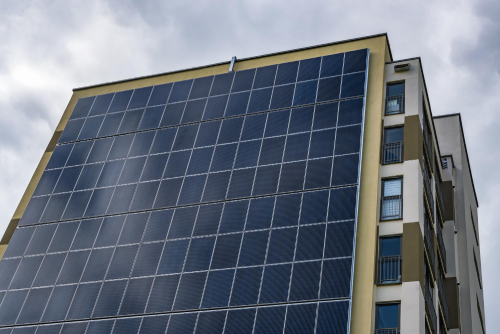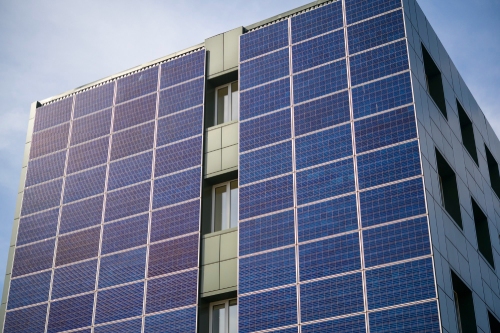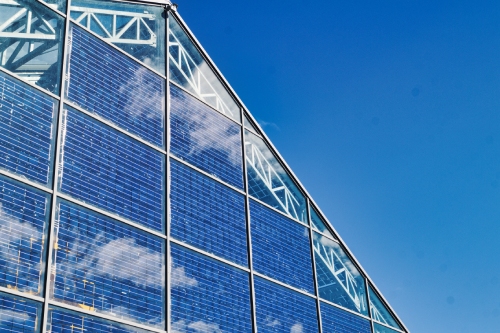What Is a Solar Facade?
The popularity of solar facade systems is increasing as cities and buildings seek cleaner energy. Solar facade is not merely a rooftop solar panel. It is solar panel technology that integrates into building facades, windows, and coverings. This implies that the buildings have the capability of producing solar power without the unsightly rooftop panels. In this guide, we explore solar panel facade systems, elaborate on solar facade design, and address the question: Is it a good idea to invest in solar facade cladding in 2025? We will consider the advantages, limitations, and installation procedures, including facade-mounted solar panels, as well as the importance of facade architecture in solar panel buildings in contemporary buildings.
How Solar Facade Systems Work
Solar panels on the facade collect the sun’s rays that fall on the exterior of the building. The panels have photovoltaic cells which convert sunlight into electricity. This energy could be used for lighting, heating, cooling, or supplied back into the grid. Solar panel facade systems are typically connected to the building’s electrical system. It employs inverters and safety equipment. The system may generate a significant amount of power, especially on sunniest walls, depending on the amount of sunlight access to the facade. Vertical panels can also be used to shade the building, thereby reducing cooling requirements.
Benefits of a Solar Panel Facade
The most positive aspect of solar facade systems is their energy-saving capabilities. Buildings consume less grid electricity and utility bills. The electricity generated also reduces the carbon footprint and helps combat global warming. Factories or offices can enjoy these savings in the long term.
The use of solar facade panels will also save space. Rooftops may be overcrowded or shaded, whereas the facades of buildings are usually wasted spaces with huge potential. Combining solar panels with walls utilizes the relatively unused space in the wall.
Architecture with a solar panel facade provides an aesthetic value. Facade solar panels can have sleek faces, pattern pieces or tinted windows instead of a uniform wall. The addition of a solar facade design to a building makes it a more innovative structure. It also conveys a message on sustainability.
Some walls are exposed to direct sunlight while others are not. Architects can design the facades of buildings to face south, southwest, or southeast to maximize energy efficiency. Individual panels may be positioned to comply with aesthetic objectives or a creative pattern. The variety of colours, materials, and textures of the solar facade cladding systems aligns with the building’s style.
Are Solar Facades Cost-Effective in 2025?

There is also a frequent question whether it is worth investing in solar facade systems at the moment. Although the initial cost may be expensive, it appears to save you money in the long run. Solar panel facade systems generate power that lowers utility expenses both now and in future. Facade-integrated solar panels often come with incentives, rebates and tax credits. These serve to compensate for preliminary costs.
Facade systems of solar panels are durable. Panels normally perform well for approximately twenty to thirty years without much maintenance. Considering the energy savings, rebate programs, and low maintenance costs, buildings typically pay off within a fairly short period. The solar facade then proceeds to provide free electricity.
Additionally, sustainable or green buildings tend to be priced higher when sold or rented. Property value can be increased by installing solar panels on the building facade. Buyers or tenants may prefer buildings that use clean energy and pay lower costs.
Challenges to Consider
There are certain issues with solar facades. First, vertical or inclined panels may not receive as much sunlight as rooftop panels. Other buildings or trees can shade some of the walls.
Another reason is the higher initial cost. Facade systems with solar panels require more investment than the roof system. This specialized panelling, framing, and architectural work is expensive. Construction teams must consider budgets, schedules, and long-term savings.
The complexity of integration also matters. The installation of panels within the facade poses a challenge, and engineering should be carried out to ensure weatherproofing, safety, and optimal performance. A new construction or a remodelled building should be planned with the presence of solar facade systems. Retrofit projects can enhance complexity.
The design of the solar facade also requires coordination among architects, engineers, and contractors. The system should satisfy the requirements of safety, wind load, electrical standards and insulation. Buildings should collaborate with experts who specialize in facade-integrated solar solutions to provide high-quality services.
Recent Trends and Innovation
Solar facade systems are changing. The new photovoltaic materials are slimmer, more efficient and bendable. They may be rounded off to suit curving walls or to special glass finishes. Solar panel facades are becoming a strategy in green building within big cities and institutions. Solar facades are being made mainstream by the global drive towards a net-zero carbon environment, as well as building technologies that promote the incorporation of renewable energy sources.
Solar technology is becoming increasingly affordable. The installation process and manufacturing process are also more efficient compared to past years. This makes solar facade systems more affordable and appealing.
Where to Use Solar Facade Systems

Various building types can utilize solar panel facade systems. Sun-facing walls are typically featured in office buildings to capture energy and enhance branding value. Solar facade cladding can be used in multi-storey housing to improve energy efficiency and maintain a fashionable appearance. Educational and research institutions can take the lead by installing solar panels on their building facades. Solar facade design can be incorporated into the brand image of retail and public buildings, attracting visitors.
Facade solar panels can be mounted on walls and are an effective solution for capturing energy in small urban spaces. Retrofit projects can replace existing cladding with solar-integrated materials. Photovoltaic solar panel facade systems can also be integrated into new buildings on the ground.
Key Factors When Planning a Solar Facade
First, consider the amount of sun that each wall will receive. Your solar facade will generate more energy depending on its orientation, the shade it receives, and the local climate.
Then, review local policies. In many areas, rebates or incentives are available for building facade systems with solar panels. Designing with a solar facade can be favoured in green codes or energy regulations. It is crucial to understand the rules of integration and testing, as well as the underlying principles.
Select high-quality solar facade cladding and finishing. Seek the suppliers of solar panel facades that will guarantee certified ACP glass or panel systems. The system should be integrated with waterproofing, insulation, and electrical wiring.
Provision of structural and weather-proofing requirements. The cladding should resist the wind pressure, drainage, and thermal variation. Flashings and seals must be installed correctly and with precision when fixing panels.
Seek experience in solar panel facade construction. Designers familiar with architectural solar systems will handle installation, wiring, permits, and testing. Enquire about performance warranties and surveillance.
Finally, compare the long-term benefits. Calculate the savings in energy, maintenance, aesthetic value, and incentives. Considering the environmental and financial advantages will help you decide whether investing in a solar facade system is a worthwhile choice.
Case Examples and Market Growth
Solar facades are already in use in some modern buildings. Solar panels are sometimes installed on curved facades or atria in university campuses and airports. These structures generate their own power, and they make a statement. New residential accommodations in Europe use coloured or tinted solar panels made of photovoltaics in their facades. The panels are aesthetically designed to produce energy.
Market data indicate that demand is increasing both in facade-integrated solar and rooftop solar. With the rise in the quality of technology and its corresponding reduction in price, more architects and developers are incorporating solar panel building facades into their green building plans. Solar facades in cities that target zero-energy building objectives advance the achievement of climate objectives.
The Business Research Company reports that the facade system market size has grown strongly in recent years. It is projected to grow from $363.24 billion in 2024 to $393.54 billion in 2025, at a compound annual growth rate (CAGR) of 8.3%.
Is a Solar Facade Right for You?

Solar facade systems are perfect for innovative projects with sustainability goals. They work well for projects that get enough sunlight on the exterior walls. Solar facade systems can be installed in urban infill sites, apartment buildings, business centres, and public buildings. Savings and incentives help offset the initial cost. Panels are durable, visually appealing, and environmentally friendly in terms of carbon emissions.
Nevertheless, it might be more affordable and less hassling in simple structures with good roof exposure to the sun. The rooftop system could save a significant amount of money, but a solar facade could introduce additional complications and costs. Every project has a facade and roof that a solar consultant or a facade solar panel architect should evaluate.
In the case of retrofitting buildings with limited roof options or worn-out exteriors, reusing old cladding with solar-integrated panels can prove more valuable than traditional facades. The solar facade design presents an opportunity to enhance insulation, modernize the building’s appearance, and provide shading to reduce power consumption.
Conclusion
In 2025, solar facade is emerging as an attractive long-term business interest for buildings in terms of resilience, design, and clean energy. They combine architecture with efficiency in energy production. Although they can be expensive in the short term, they are worth it due to lower energy bills, subsidies, tax credits, improved aesthetics, and increased building value. By selecting an appropriate installation group, high-quality materials, and proper orientation, you can maximize the benefits of facade-mounted solar panels.
Ontario Panelization can assist you if you are considering installing solar panels on your building’s facade. We offer well-structured solar facade systems, design assistance, and installation services. Regardless of whether you require facade-integrated solar panels during new construction or wish to modernize an existing structure, our team will assist you with any part of the process in Ontario and neighbouring areas.
Contact us now to discover how a solar panel facade can enhance the design, performance, and value of your building. What would you say to a brighter and sustainable future?